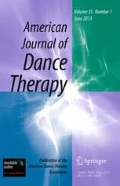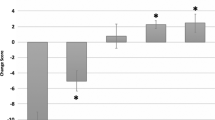Abstract
Previous studies indicate that mindfulness interventions and physical activities can produce positive effects on mood disorders; such activities may be options for individuals who search for non-traditional therapies, or whenever mainstream psychological treatments are not effective. We explored the effects of tango dance, meditation, and exercise (circuit training) in individuals with self-reported depression. Participants were randomly placed into meditation, exercise, tango dance, or control-wait-list groups. Sixty-four participants completed the 8-week program and were assessed before, after, and at 1-month follow-up. The dependent variables were depression, anxiety, stress, fatigue, and insomnia (symptoms measures), and self-efficacy, satisfaction with life, and mindfulness (positive psychology measures). Treatment scores were compared with the control group scores. The meditation group showed benefits at follow-up for depression, stress, and satisfaction with life. The exercise group showed decreased depression and increased self-efficacy at post-test, but only self-efficacy was persistent at follow-up, whereas stress was just significant at follow-up. The tango group showed decreased depression and insomnia and increased satisfaction with life and mindfulness at post-test. All, except for satisfaction with life, were persistent at follow-up, while stress and anxiety improved only at follow-up. As expected, the control group maintained similar scores across pre-test and post-test, and at follow-up. Tango dance was shown to induce a broader and more persistent range of benefits. Meditation produced lasting benefits only when well-learned and practiced, whereas exercise generated rapid benefits, but, except for self-efficacy, temporary. Such differences may provide valuable information when promoting these activities to best match the individual needs within this population.
Similar content being viewed by others
Change history
11 December 2019
There were some errors presented in Table��2 in the original article. Values have been corrected in the version of Table��2 presented here.
References
Afari, N., & Buchwald, D. (2003). Chronic fatigue syndrome: A review. The American Journal of Psychiatry, 160(2), 221–236.
Antony, M. M., Bieling, P. J., Cox, B. J., Enns, M. W., & Swinson, R. P. (1998). Psychometric properties of the 42-item and 21-item versions of the Depression Anxiety Stress Scales in clinical groups and a community sample. Psychological Assessment, 10(2), 176–181.
Atienza, F. L., Pons, D., Balaguer, I., & García-Merita., (2000). Propiedades psicométricas de la escala de satisfacción con la vida en adolescentes. Psicothema, 12(2), 314–319.
Baer, R. A. (2003). Mindfulness training as a clinical intervention: A conceptual and empirical review. Clinical Psychology: Science & Practice, 10, 125–142.
Barriopedro, I., Eraña, I., & Mallol, L. (2001). Relación de la actividad física con la depresión y satisfacción con la vida en la tercera edad. Revista de Psicología del Deporte, 10(2), 239–246.
Bastien, C. H., Vallières, A., & Morin, C. M. (2001). Validation of the Insomnia Severity Index as an outcome measure for insomnia research. Sleep Medicine, 2(4), 297–307.
Behrends, A., Müller, S., & Dziobek, I. (2012). Moving in and out of synchrony: A concept for a new intervention fostering empathy through interactional movement and dance. The Arts in Psychotherapy, 39(2), 107–116.
Bluestein, D., Rutledge, C. M., & Healey, A. C. (2010). Psychosocial correlates of insomnia severity in primary care. Journal of the American Board of Family Medicine, 23(2), 204–211.
Brown, K. W., & Ryan, R. M. (2003). The benefits of being in the present: Mindfulness and its role in psychological well-being. Journal of Personality and Social Psychology, 84(4), 822–848.
Buysse, D. J., Angst, J., Gamma, A., Ajdacic, V., Eich, D., & Rössler, W. (2008). Prevalence, course, and comorbidity of insomnia and depression in young adults. Sleep, 31(4), 473–480.
Carlson, L. E., & Brown, K. W. (2005). Validation of the Mindful Attention Awareness Scale in a cancer population. Journal of Psychosomatic Research, 58(1), 29–33.
Chapman, D. P., Perry, G. S., & Strine, T. W. (2005). The vital link between chronic disease and depressive disorders. Preventing chronic disease, 2(1), A14.
Christopher, M. S., & Gilbert, B. D. (2010). Incremental validity of components of mindfulness in the prediction of satisfaction with life and depression. Current Psychology, 29, 10–23.
Daley, A. (2008). Exercise and depression: A review of reviews. Journal of Clinical Psychology in Medical Settings, 15(2), 140–147.
Diener, E., Emmons, R., Larsen, R., & Griffin, S. (1985). The satisfaction with life scale: A measure of life satisfaction. Journal of Personality Assessment, 49, 71–75.
Dimidjian, S., & Linehan, M. M. (2003). Defining an agenda for future research on the clinical application of mindfulness practice. Clinical Psychology: Science and Practice, 10(2), 166–171.
Dinzel, R. (Ed.). (1999). El tango una danza; Esa ansiosa busqueda de la libertad. Buenos Aires, Argentina: Corregidor.
Faul, F., Erdfelder, E., Buchner, A., & Lang, A. (2009). Statistical power analyses using GPower 3.1: Tests for correlation and regression analyses. Behavior research methods, 41(4), 1149–1160.
Hackney, M. E., Kantorovich, S., Levin, R., & Earhart, G. M. (2007). Effects of tango on functional mobility in Parkinson’s disease: A preliminary study. Journal of Neurologic Physical Therapy, 31(4), 173–179.
Hickie, I., Koschera, A., Hadzi-Pavlovic, D., Bennett, B., & Lloyd, A. (1999). The temporal stability and co-morbidity of prolonged fatigue: A longitudinal study in primary care. Psychological Medicine, 29, 855–861.
Hollon, S. D., Thase, M. E., & Markowitz, J. C. (2002). Treatment and prevention of depression. Psychological Science in the Public Interest, 3(2), 39–77.
Jacobson, A., McKinley, P. A., & Rainville, C. (2006). Argentine tango dancing as an effective means for improving cognition, complex task performance and sense of well-being in at-risk elderly: A feasibility study. Paper Presented at the International Conference on Gait & Cognitive Function, Madrid, Spain.
Jindal, R. D., Buysse, D. J., & Thase, M. E. (2004). Maintenance treatment of insomnia: What can we learn from the depression literature? The American Journal of Psychiatry, 161, 19–24.
Kabat-Zinn, J. (1990). Full catastrophe living: Using the wisdom of your body and mind to face stress, pain, and illness. New York, NY: Dell.
Karsten, J., Nolen, W. A., Pennix, B. W. J. H., & Hartman, C. A. (2011). Subthreshold anxiety better defined by symptom self-report than by diagnostic interview. Journal of Affective Disorders, 129, 236–243.
Kessler, R. C., Soukup, J., Davis, R. B., Foster, D. F., Wilkey, S. A., Van Rompay, M. I., et al. (2001). The use of complementary and alternative therapies to treat anxiety and depression in the United States (statistical data included). American Journal of Psychiatry, 158(2), 289.
Kingston, T., Dooley, B., Bates, A., Lawlor, E., & Malone, K. (2007). Mindfulness-based cognitive therapy for residual depressive symptoms. Psychology & Psychotherapy, 80, 193–203.
Koch, S. C., Morlinghaus, K., & Fuchs, T. (2007). The joy dance: Specific effects of a single dance intervention on psychiatric patients with depression. The Arts in Psychotherapy, 34(4), 340–349.
Krogh, J., Nordentoft, M., Sterne, J. A., & Lawlor, D. A. (2011). The effect of exercise in clinically depressed adults: Systematic review and meta-analysis of randomized controlled trials. The Journal of Clinical Psychiatry, 72, 529–538.
Krupp, L. B., LaRocca, N. G., Muir-Nash, J., & Steinberg, A. D. (1989). The fatigue severity scale. Archives of Neurology, 46, 1121–1123.
Lau, M. A., & McMain, S. F. (2005). Integrating mindfulness meditation with cognitive and behavioural therapies: The challenge of combining acceptance- and change-based strategies. Canadian Journal of Psychiatry, 50(13), 863–869.
Lovibond, S., & Lovibond, P. (1995). Manual for the depression anxiety stress scales (2nd ed.). Sydney, Australia: Psychology Foundation.
Maciejewski, P. K., Prigerson, H. G., & Mazure, C. M. (2000). Self-efficacy as a mediator between stressful life events and depressive symptoms. British Journal of Psychiatry, 176, 373–378.
Mala, A., Karkou, V., & Meekums, B. (2012). Dance/movement therapy (DMT) for depression: A scoping review. The Arts in Psychotherapy, 39(4), 287–295.
Masedo, A. I., & Esteve, M. R. (2007). Effects of suppression, acceptance, and spontaneous coping on pain tolerance, pain intensity, and distress. Behaviour Research and Therapy, 45, 199–209.
Mason, O., & Hargreaves, I. (2001). A qualitative study of mindfulness-based cognitive therapy for depression. British Journal of Medical Psychology, 74, 197–212.
McAuley, E., Blissmer, B., Marquez, D. X., Jerome, G. J., Kramer, A. F., & Katula, J. (2000). Social relations, physical activity, and well-being in older adults. Preventive Medicine, 31, 608–617.
McAuley, E., Jerome, G. J., Elavsky, S., Marquez, D. X., & Ramsey, S. N. (2003). Predicting long-term maintenance of physical activity in older adults. Preventive Medicine, 37, 110–118.
McKinley, P., Jacobson, A., Bednarczyk, V., Leroux, A., Rossignol, M., & Fung, J. (2008). Effect of a community-based Argentine tango dance program on functional balance and confidence in older adults. Journal of Aging & Physical Activity, 16(4), 435–453.
Murray, J., & Lopez, A. (1996). Summary: The global burden of disease. Boston, MA: Harvard School of Public Health.
Nau-Klapwijk, N. (2006). Tango, un Baile Bien Porteño. Buenos Aires, Argentina: Corregidor.
Neuberger, G. B. (2003). The Fatigue Questionnaire, Fatigue Severity Scale, Multidimentional Assessment of Fatigue Scale, and Short Form-36 Vitality (Energy/Fatigue) Subscale of the Short Form Health Survey. Arthritis and Rheumatism, 49(5), 175–183.
Nuyen, J., Volkers, A. C., Verhaak, P. F. M., Schellevis, F. G., Groenewegen, P. P., & Bos, G. A. M. V. D. (2005). Accuracy of diagnosing depression in primary care: The impact of chronic somatic and psychiatric co-morbidity. Psychological Medicine, 35, 1185–1195.
O’Brien, E. M., Chelminski, I., Young, D., Dalrymple, K., Hrabosky, J., & Zimmerman, M. (2011). Severe insomnia is associated with more severe presentation and greater functional deficits in depression. Journal of Psychiatric Research, 45(8), 1101–1105.
Peidro, R. M., & Comasco, R. (2007). Con el Corazon en el tango. Guia para prevenir enfermedades cardiacas bailando tango. Buenos Aires, Argentina: Guadal.
Phillips, W. T., Kiernan, M., & King, A. C. (2003). Physical activity as a nonpharmacological treatment for depression: A review. Complementary Health Practice Review, 8(2), 139–152.
Pinniger, R., Brown, R. F., Thorsteinsson, E. B., & McKinley, P. (in press). Argentine tango dance compared to mindfulness meditation and a waiting-list control: A randomised trial for treating depression. Complementary Therapies in Medicine. doi:10.1016/j.ctim.2012.07.003. Retrieved from http://dx.doi.org.ezproxy.une.edu.au/10.1016/j.ctim.2012.07.003
Psychology Foundation of Australia. (2011). The Depression Anxiety Stress Scales (DASS). Sydney, Australia: Psychology Foundation of Australia.
Quiroga Murcia, C., Bongard, S., & Kreutz, G. (2009). Emotional and neurohumoral responses to dancing tango argentino: The effects of music and partner. Music and Medicine, 1, 14–21.
Ree, M. J., & Craigie, M. A. (2007). Outcomes following mindfulness-based cognitive therapy in a heterogeneous sample of adult outpatients. Behaviour Change, 24(2), 70–86.
Savard, M., Savard, J., Simard, S., & Ivers, H. (2005). Empirical validation of the Insomnia Severity Index in cancer patients. Psycho-Oncology, 14(6), 429–441.
Scholz, U., Benicio Gutierrez, D., Sud, S., & Schwarzer, R. (2002). Is general self-efficacy a universal construct? 1: psychometric findings from 25 countries. European Journal of Psychological Assessment, 18(3), 242.
Schutte, N. S., & Malouff, J. M. (1995). Sourcebook of adult assessment strategies. New York, NY: Plenum.
Schwarzer, R., & Jerusalem, M. (1995). Generalized self-efficacy scale. In J. Weinman, S. Wright, & M. Johnston (Eds.), Measures in health psychology: A user’s portfolio. Causal and control beliefs (pp. 35–37). Windsor: NFER-Nelson.
Segal, Z., Williams, J. M., & Teasdale, J. D. (2002). Mindfulness-based cognitive therapy for depression: A new approach to preventing relapse. New York, NY: Guilford Press.
Seyler, E. M. (2007). Dancing toward integration: A mixed-methods study of argentine tango, adult health/well-being, aging, and spirituality in Philadelphia. Paper presented at the Society of Dance History Scholars Conference.
Stewart, N. J., McMullen, L. M., & Rubin, L. D. (1994). Movement therapy with depressed inpatients: A randomized multiple single case design. Archives of Psychiatric Nursing, 8(1), 22–29.
Teasdale, J. D., Segal, Z., & Williams, J. M. G. (1995). How does cognitive therapy prevent depressive relapse and why should attentional control (mindfulness) training help? Behaviour Research and Therapy, 33(1), 25–39.
Teasdale, J. D., Segal, Z. V., Williams, M. G., Ridgeway, V. A., Soulsby, J. M., & Lau, M. A. (2000). Prevention of relapse/recurrence in major depression by mindfulness-based cognitive therapy. Journal of Consulting and Clinical Psychology, 4(68), 615–623.
Toneatto, T., & Nguyen, L. (2007). Does mindfulness meditation improve anxiety and mood symptoms? A review of controlled research. Canadian Journal of Psychiatry, 52(4), 260–266.
Trossero, F. (2006). Tango Terapia. Rosario: Coqueña Ediciones.
Turner, E. H., & Rosenthal, R. (2008). Efficacy of antidepressants. British Medical Journal, 336(7643), 516–517.
Wessely, S., Chalder, T., Hirsch, S., Wallace, P., & Wright, D. (1996). Psychological symptoms, somatic symptoms, and psychiatric disorder in chronic fatigue and chronic fatigue syndrome: A prospective study in the primary care setting. The American Journal of Psychiatry, 153, 1050–1059.
WHO. (2012). Depression. Geneva: World Health Organization (WHO). Retrieved from http://www.who.int/mentalhealth/management/depression/definition/en/
Acknowledgments
We are indebted to Jacqueline Simpson (tango instructor) and Anthony Miller (assistant instructor), Tom Jones (clinical psychologist and meditation instructor), and John Dowse (exercise instructor) for their time and dedication in preparing and carrying out the program. We also wish to thank the tango team, including Annabella Chang, Nga Nguyen, David Owen, Elcira Ratero, Paula Schooge, and Jean Weiner, for their time and professionalism in assisting as leaders at the tango classes; as well as Pedro Colombi (Argentinean Consul, Sydney, Australia) for his support in this project; “The Kirk” (venue at Surry Hills, Sydney) for providing an ideal space to conduct the program; and all the participants whose commitment made the study possible and established grounds for future research.
Author information
Authors and Affiliations
Corresponding author
Rights and permissions
About this article
Cite this article
Pinniger, R., Thorsteinsson, E.B., Brown, R.F. et al. Tango Dance Can Reduce Distress and Insomnia in People with Self-Referred Affective Symptoms. Am J Dance Ther 35, 60–77 (2013). https://doi.org/10.1007/s10465-012-9141-y
Published:
Issue Date:
DOI: https://doi.org/10.1007/s10465-012-9141-y




